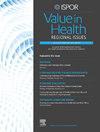比较初步版EuroQol健康与幸福与EQ-5D-5L在患者、健康公众和护理人员中的测量特性
IF 1.5
Q3 HEALTH CARE SCIENCES & SERVICES
引用次数: 0
摘要
目的EuroQol健康与幸福(EQ-HWB)是一种新的通用生活质量(QOL)问卷,比EQ-5D-5L更广泛地捕捉健康和幸福的方面。本研究考察了EQ-HWB初版在患者、健康个体和健康护理者中的测量特性。方法在线招募(1)有或没有照顾者任务的受访者,(2)患有不同疾病的受访者,(3)身体健康的受访者。探讨了天花板效应、收敛效度和发散效度、已知疾病和照顾者群体差异,并采用探索性因素分析。结果共纳入调查对象500人,其中健康个体100人(不包括健康护理人员40人),慢性乙型肝炎患者122人,HIV/AIDS患者101人,抑郁症患者107人,广泛性焦虑症患者90人。EQ-HWB活动维度与EQ-5D-5L行动能力、自我照顾和日常活动维度相关性最强,而EQ-HWB身体感觉维度与EQ-5D-5L疼痛/不适维度相关性最强。EQ-HWB的其他维度(自我认同、认知、自主性、感觉和情绪以及人际关系)与EQ-5D-5L焦虑/抑郁维度最接近。这两种工具都区分了健康个体和患者的疾病负担,并确定了护理的作用。EQ-5D-5L在探索性因子分析中包含3个因子,EQ-HWB在探索性因子分析中包含2个因子(F1认知、F2身体活动、F3感觉和情绪、F4积极项目和F5身体感觉)。结论seq - hwb与EQ-5D具有相同的概念结构,能够测量健康人、患者和护理人员的健康相关生活质量。EQ-HWB在心理健康状况患者中比EQ-5D更敏感。这些结果支持EQ-HWB将幸福感与健康相关的生活质量结合起来。本文章由计算机程序翻译,如有差异,请以英文原文为准。
Comparing the Measurement Properties of the Preliminary Version of the EuroQol Health and Well-Being and EQ-5D-5L in Patients, Healthy General Public, and Caregivers
Objectives
The EuroQol Health and Well-Being (EQ-HWB) is a new generic quality of life (QOL) questionnaire to capture broader aspects of health and well-being than EQ-5D-5L. This study examined the measurement properties of the preliminary EQ-HWB version in patients, healthy individuals, and healthy caregivers.
Methods
Respondents (1) with or without caregiver tasks, (2) with different diseases, or (3) in full health were recruited online. Ceiling effects, convergent and divergent validity, known disease, and caregiver group differences were explored, and an exploratory factor analysis was used.
Results
A total of 500 respondents were recruited, including 100 healthy individuals (excluding 40 healthy caregivers), 122 with chronic hepatitis B, 101 with HIV/AIDS, 107 with depression, and 90 with generalized anxiety disorder. The EQ-HWB activities dimension correlated most highly with the EQ-5D-5L mobility, self-care, and usual activities dimensions, whereas EQ-HWB physical sensation dimension was strongly related to the EQ-5D-5L pain/discomfort dimension. Additional EQ-HWB dimensions (self-identity, cognition, autonomy, feelings and emotions, and relationships) aligned most closely with the EQ-5D-5L anxiety/depression dimension. Both instruments differentiated disease burden across healthy individuals and patients and identified caregiving roles. The EQ-5D-5L revealed 3 factors in exploratory factor analysis, whereas the EQ-HWB included 2 additional factors (F1 cognition, F2 physical activity, F3 feelings and emotions, F4 positive items, and F5 physical sensation).
Conclusions
EQ-HWB is able to measure health-related QOL in healthy people, patients, and caregivers given that it shares the same conceptual structure with EQ-5D. EQ-HWB is more sensitive in patients with mental health conditions than the EQ-5D. These results support that EQ-HWB captures well-being alongside health-related QOL.
求助全文
通过发布文献求助,成功后即可免费获取论文全文。
去求助
来源期刊

Value in health regional issues
Pharmacology, Toxicology and Pharmaceutics-Pharmacology, Toxicology and Pharmaceutics (miscellaneous)
CiteScore
2.60
自引率
5.00%
发文量
127
 求助内容:
求助内容: 应助结果提醒方式:
应助结果提醒方式:


